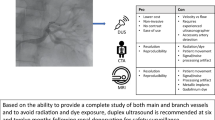Abstract
Clinical experience indicates that hypertensive excretory urography is not a satisfactory screening examination to detect patients having hypertension due to renal artery stenosis. Review of the Cooperative Study data indicates the false negative rate for screening was 21.8%. In addition, the prevalence of hypertension caused by renal artery stenosis appears quite low, in the range of 1–3%. Since the objective is to identify patients who will benefit from surgery, clinical sorting strategy should focus on evaluating patients as surgical candidates, not as having the disease. Once that is done, pharmacodynamic renal arteriography is recommended as the first imaging examination to find the renal artery lesion and determine its hemodynamic significance.
Similar content being viewed by others
References
Bailey SM, Evans DW, Fleming HA: Intravenous urography in investigation of hypertension.Lancet 2:57–58, 1975
Lewis PJ, Bulpitt CJ, Sherwood T, Dollery CT: Routine intravenous urography in the investigation of hypertension.J Chronic Dis 29:785–791, 1976
Stolle E, Gotzen R, Khalil M: Der wert des fruhurogramms bei der abklarung einer arteriellen hypertonie.Fortschr Roentgenstr 127:238–242, 1977
Thornbury JR, Stanley JC, Fryback DG: The hypertensive urogram: a nondiscriminatory test for renovascular hypertension,AJR, in press
Bookstein JJ, Abrams HL, Buenger RE, Lecky J, Franklin SS, Reiss MD, Bleifer KH, Klatte EC, Varady PD, Maxwell MH: Radiologic aspects of renovascular hypertension. Part 1. Aims and methods of the radiology study group. Part 2. The role of urography in unilateral renovascular disease. Part 3. Appraisal of arteriography. Part 4. Arteriographic complications.JAMA 220:1218–1230;221:368–378 (also220:1195–1204, 1209–1218 for additional parts), 1972
McNeil BJ, Mellins HZ: Evaluation of diagnostic tests in uroradiology.Radiol Clin North Am 17:175–185, 1979
Tucker RM, Labarthe DR: Frequency of surgical treatment for hypertension in adults at the Mayo Clinic from 1973 throught 1975.Mayo Clin Proc 52:549–555, 1977
Bookstein JJ, Walter JF, Staniey JC, Fry WJ: Pharmacoangiographic manipulation of renal collateral blood flowCirculation 54:328–334, 1976
Stanley JC, Fry WJ: Renovascular hypertension secondary to arterial fibrodysplasia in adults.Arch Surg 110:922–928, 1975
Hillman BJ, Ovitt TW, Nudelman S, Fisher HD III, Frost MM, Capp MP, Roehrig H, Seeley G: Digital video subtraction angiography of renal vascular abnormalities.Radiology 139:277–280, 1981
Author information
Authors and Affiliations
Rights and permissions
About this article
Cite this article
Thornbury, J.R., Stanley, J.C. & Fryback, D.G. Limited use of hypertensive excretory urography. Urol Radiol 3, 209–211 (1982). https://doi.org/10.1007/BF02938804
Issue Date:
DOI: https://doi.org/10.1007/BF02938804




